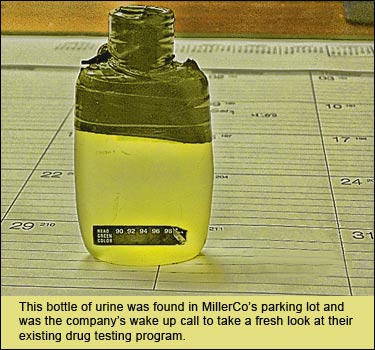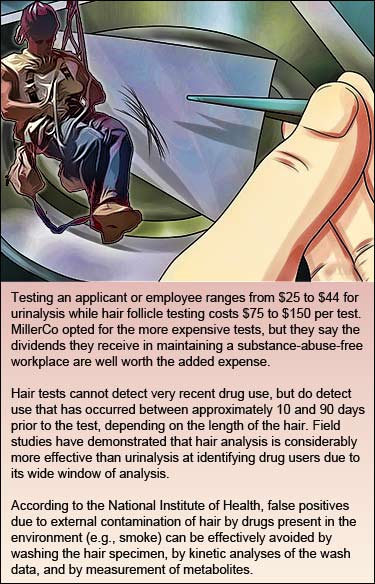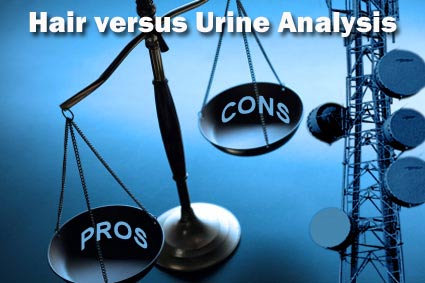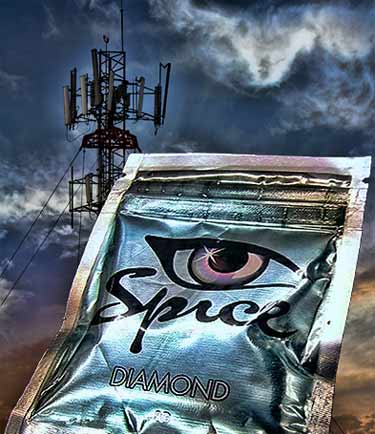A bottle of urine helped to revamp a national contractor's drug screening program
By Richard Chapman
July 18, 2014 – Contractors unanimously agree that drug testing within our industry is not an option, but a hard-and-fast regulation. And in an industry that appeals to young men and women who  tend to have risk-taking personalities, it is inevitable that a percentage of that workforce would engage in drug use.
tend to have risk-taking personalities, it is inevitable that a percentage of that workforce would engage in drug use.
 However, while virtually any contractor in business today will claim that they promote a drug-free workplace, one sometimes has to wonder if those policies are just compliance-driven, or truly sincere efforts to maintain a safe working environment.
However, while virtually any contractor in business today will claim that they promote a drug-free workplace, one sometimes has to wonder if those policies are just compliance-driven, or truly sincere efforts to maintain a safe working environment.
So what does a serious substance abuse program require? At a minimum, a company should practice pre-employment screening, random screening, and for-cause screening. For-cause can be triggered by a traffic or workplace accident, or documented suspicion of impairment or documented consistent poor performance. Within our company, MillerCo, Inc., any of these will generate a drug test. In addition, a “near-miss” incident will initiate one as well.
Once you have your policies in place, what kind of drug test is best for your situation?
Urinalysis is the most common, but this test can be defeated by a determined employee. Hair follicle testing is much more difficult to defeat, but has the drawback of requiring that a sample be sent off for analysis, usually taking two to three days to get results. In addition, they are typically more expensive, although the prices have begun to fall somewhat. The answer, at least for MillerCo, Inc., has been a combination of both.
A bottle-based epiphany
From our inception 16 years ago, MillerCo has promoted a drug-free workplace, backed up by urinalysis drug testing. Although we thought that we were being very aggressive about it, in spite of our efforts, we still felt that some of our 60-plus employees were somehow defeating our system.
This belief was reinforced in mid-2013 when a bottle of urine was found in our parking lot, causing us to question ourselves as to the success of our program. It also forced us to confront the question: “Are we just doing the minimum required, to insure  compliance, or are we really serious about maintaining a drug-free workplace?” This led us to reevaluate our entire drug screening program.
compliance, or are we really serious about maintaining a drug-free workplace?” This led us to reevaluate our entire drug screening program.
Up until this point we had utilized pre-employment testing, for-cause testing, and random testing. All of these were urinalysis tests. In fact, it was not unusual for a supervisor to randomly show up on a site and conduct a urine test on the spot. And we would occasionally catch an offender. Yet we had to face the fact that some were slipping through the cracks.
Fair warning notice given
In November 2013, MillerCo conducted a three-day safety stand-down. We brought every employee in to our corporate headquarters in Gulfport, Miss. In addition to dealing with administrative issues, we spent many hours re-enforcing the need for fall protection, electrical safety, environmental hazards, and other typical industry safety issues. At that time, an announcement was made that effective 2014, we would begin hair follicle testing company-wide.
In March 2014, we initiated the program. Management and supervisory personnel were the first tested and then we moved on to the field personnel.
Losing a number of workers was a weighty concern
It would be disingenuous to say that there wasn’t a little trepidation among management. “What if we lose a lot of people?” was the unspoken gorilla in the room at staff meetings. As the first results started to come in, we began to breathe a little easier. And as more and more results came back negative, that sense of concern began to go away, replaced with a renewed pride in our employees. Ultimately, we had a 100% pass rate.
Now, some would say that we should not have given them warning. And this was debated at length. Ultimately we decided that if they were otherwise a good employee, this would be our opportunity to either make them a better employee, or to remove them from our workplace, thus making our workplace safer for the responsible, drug-free employees.
One could also argue that we wasted money on the more expensive hair testing, since everyone passed, but we hardly think so. In fact, we believe it is saving us money. While we had no current employees fail, we have had a few employee candidates rejected for failing their hair tests. Had we used urinalysis, those candidates could have easily cleaned up long enough to pass it.
But very few applicants plan three to six months ahead of contacting a prospective employer. In addition, there are less tangible, but much more important, benefits to our program. When our employees understood that we were not winking at drug issues, they took more pride in their work and in their company. They feel more comfortable about approaching management if they have suspicions about a coworker.
They openly bragged to other climbers in person and on social media about the efforts of the company to provide a safe, drug-free workplace. This in turn has become a great recruiting tool. We have had Tower Technicians from other companies come to us seeking employment, and in many cases, they specifically quote our drug policies as being the reason they want to work for us.
Balancing the pros and the cons
Generally speaking, urinalysis testing is the norm within the industry. While it has its place, and in fact we still use it for spot checks, it is less successful than hair follicle  testing. It also requires a certain level of stealth; otherwise, if a crew is aware that they are being sent to a testing facility, they have the ability to take steps to defeat it. On the pro side, they can be read instantly. This is an advantage in that if you are testing an employee, for example, because they were involved in a minor traffic accident, you want to verify they are clean before allowing them to return to work. And while urinalysis tests are less expensive, they are also more susceptible to legal challenges.
testing. It also requires a certain level of stealth; otherwise, if a crew is aware that they are being sent to a testing facility, they have the ability to take steps to defeat it. On the pro side, they can be read instantly. This is an advantage in that if you are testing an employee, for example, because they were involved in a minor traffic accident, you want to verify they are clean before allowing them to return to work. And while urinalysis tests are less expensive, they are also more susceptible to legal challenges.
Hair follicle testing, while not as common within the tower industry, is gaining a following, and for good reason. The need to play the “gotcha game” is eliminated. So far, they haven’t figured out how to buy sterile hair! Because it requires that the sample be sent off, it is time consuming, and less desirable if you are trying to decide if you can put a crew back on the road after an incident.
However, in some cases, when confronted with the hair follicle test, the employee will choose to resign, rather than take the test, if he/she knows they will fail it. On the pro side, in court, it is much harder for an employee to contest a positive hair follicle test.
So which is best for your company? That is for each CEO to decide, but ultimately, if a company is serious about providing a drug-free workplace for their employees, both should be in their toolbox, and both should be used aggressively.
Weed out synthetic marijuana users
The latest trend is faux marijuana drugs. Some of the original ones were called “Spice” or “K2”.These drugs are frequently used in an attempt to evade drug policies.  Unfortunately, this has created more serious issues, as these concoctions are unpredictable, and very often contain chemicals that are even more dangerous than the ones they are trying to simulate. Extremely bad reactions and even deaths have been reported as a result of people using these substances.
Unfortunately, this has created more serious issues, as these concoctions are unpredictable, and very often contain chemicals that are even more dangerous than the ones they are trying to simulate. Extremely bad reactions and even deaths have been reported as a result of people using these substances.
If your drug policy does not address these situations, it should. There are urinalysis test kits for these substances on the market, and they are relatively inexpensive. But then, cost is relative. What is one life, or even one accident, worth to your company?
An important side note: One cannot discuss drug abuse, and ignore the most commonly abused drug, alcohol. This is a very serious concern within our industry, probably even more prevalent than illegal substance abuse. Thus, it deserves its own discussion.
About the author: Richard Chapman is the Training and Safety Coordinator for MillerCo Inc, a position he has held since 2006. He has been with the company since 2000, having  started as a tower lighting technician. He previously worked as a firefighter/paramedic, retiring after 24 years of service.
started as a tower lighting technician. He previously worked as a firefighter/paramedic, retiring after 24 years of service.
About his employer: Established in 1998 by James Miller, MillerCo Inc. serves the wireless communication industry, specializing in FAA lighting repairs and upgrades. They are recognized contractors for all the major property holders in the industry and provide service to 30 states in the U.S. They are long-time members of the NATE STAR Initiative and Miller sits on the NATE Board of Directors.